rabbitmq的5种消息队列
1、七种模式介绍与应用场景
1.1 简单模式(hello world)

一个生产者对应一个消费者,rabbitmq 相当于一个消息代理,负责将 a 的消息转发给 b。
应用场景:将发送的电子邮件放到消息队列,然后邮件服务在队列中获取邮件并发送给收件人。
1.2 工作队列模式(work queues)
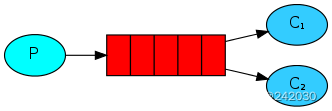
在多个消费者之间分配任务(竞争的消费者模式),一个生产者对应多个消费者,一般适用于执行资源密集型任务,
单个消费者处理不过来,需要多个消费者进行处理。
应用场景:一个订单的处理需要10s,有多个订单可以同时放到消息队列,然后让多个消费者同时处理,这样就是
并行了,而不是单个消费者的串行情况。
1.3 订阅模式(publish/subscribe)
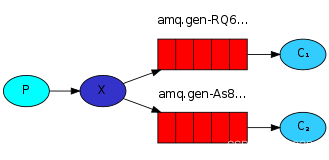
一次向许多消费者发送消息,一个生产者发送的消息会被多个消费者获取,也就是将消息将广播到所有的消费者
中。
应用场景:更新商品库存后需要通知多个缓存和多个数据库,这里的结构应该是:
- 一个 fanout 类型交换机扇出两个个消息队列,分别为缓存消息队列、数据库消息队列
- 一个缓存消息队列对应着多个缓存消费者
- 一个数据库消息队列对应着多个数据库消费者
1.4 路由模式(routing)
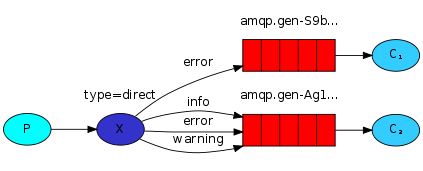
有选择地 (routing key) 接收消息,发送消息到交换机并且要指定路由 key,消费者将队列绑定到交换机时需要指
定路由 key,仅消费指定路由 key 的消息。
应用场景:如在商品库存中增加了 1 台 iphone12,iphone12 促销活动消费者指定 routing key 为 iphone12,只
有此促销活动会接收到消息,其它促销活动不关心也不会消费此 routing key 的消息。
1.5 主题模式(topics)
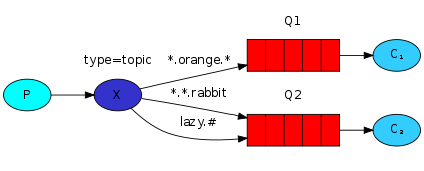
根据主题 (topics) 来接收消息,将路由 key 和某模式进行匹配,此时队列需要绑定在一个模式上,#匹配一个词
或多个词,*只匹配一个词。
应用场景:同上 iphone 促销活动可以接收主题为 iphone 的消息,如 iphone12、iphone13 等。
1.6 远程过程调用(rpc)
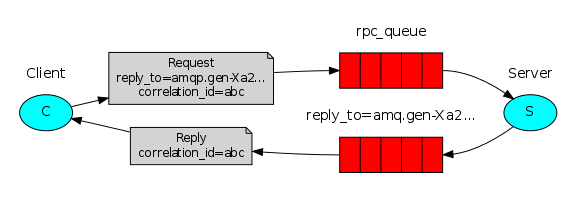
如果我们需要在远程计算机上运行功能并等待结果就可以使用 rpc,具体流程可以看图。
应用场景:需要等待接口返回数据,如订单支付。
1.7 发布者确认(publisher confirms)
与发布者进行可靠的发布确认,发布者确认是 rabbitmq 扩展,可以实现可靠的发布。在通道上启用发布者确认
后,rabbitmq 将异步确认发送者发布的消息,这意味着它们已在服务器端处理。
应用场景:对于消息可靠性要求较高,比如钱包扣款。
2、代码演示
<dependency>
<groupid>com.rabbitmq</groupid>
<artifactid>amqp-client</artifactid>
<version>5.6.0</version>
</dependency>
2.1 简单模式
package simple;
import com.rabbitmq.client.channel;
import com.rabbitmq.client.connection;
import com.rabbitmq.client.connectionfactory;
import java.io.ioexception;
import java.util.concurrent.timeoutexception;
public class sender {
private final static string queue_name = "simple_queue";
public static void main(string[] args) throws ioexception, timeoutexception {
connectionfactory factory = new connectionfactory();
factory.sethost("localhost");
factory.setport(5672);
connection connection = factory.newconnection();
channel channel = connection.createchannel();
// 声明队列
// queue: 队列名
// durable: 是否持久化
// exclusive: 是否排外,即只允许该channel访问该队列,一般等于true的话用于一个队列只能有一个消费者来消费的场景
// autodelete: 是否自动删除,消费完删除
// arguments: 其他属性
channel.queuedeclare(queue_name, false, false, false, null);
// 消息内容
string message = "simplest mode message";
channel.basicpublish("", queue_name, null, message.getbytes());
system.out.println("[x]sent '" + message + "'");
// 最后关闭通关和连接
channel.close();
connection.close();
}
}
package simple;
import com.rabbitmq.client.channel;
import com.rabbitmq.client.connection;
import com.rabbitmq.client.connectionfactory;
import com.rabbitmq.client.delivercallback;
import java.io.ioexception;
import java.util.concurrent.timeoutexception;
public class receiver {
private final static string queue_name = "simple_queue";
public static void main(string[] args) throws ioexception, timeoutexception {
// 获取连接
connectionfactory factory = new connectionfactory();
factory.sethost("localhost");
factory.setport(5672);
connection connection = factory.newconnection();
channel channel = connection.createchannel();
channel.queuedeclare(queue_name, false, false, false, null);
delivercallback delivercallback = (consumertag, delivery) -> {
string message = new string(delivery.getbody(), "utf-8");
system.out.println(" [x] received '" + delivery.getenvelope().getroutingkey() + "':'" + message + "'");
};
channel.basicconsume(queue_name, true, delivercallback, consumertag -> {
});
}
}
[x]sent 'simplest mode message'
[x] received 'simple_queue':'simplest mode message'
2.2 工作队列模式
package work;
import com.rabbitmq.client.channel;
import com.rabbitmq.client.connection;
import com.rabbitmq.client.connectionfactory;
import com.rabbitmq.client.delivercallback;
import java.io.ioexception;
import java.util.concurrent.timeoutexception;
public class receiver1 {
private final static string queue_name = "queue_work";
public static void main(string[] args) throws ioexception, timeoutexception {
connectionfactory factory = new connectionfactory();
factory.sethost("localhost");
factory.setport(5672);
connection connection = factory.newconnection();
channel channel = connection.createchannel();
channel.queuedeclare(queue_name, false, false, false, null);
// 同一时刻服务器只会发送一条消息给消费者
channel.basicqos(1);
delivercallback delivercallback = (consumertag, delivery) -> {
string message = new string(delivery.getbody(), "utf-8");
system.out.println(" [x-1] received '" + delivery.getenvelope().getroutingkey() + "':'" + message + "'");
};
channel.basicconsume(queue_name, true, delivercallback, consumertag -> {
});
}
}
package work;
import com.rabbitmq.client.channel;
import com.rabbitmq.client.connection;
import com.rabbitmq.client.connectionfactory;
import com.rabbitmq.client.delivercallback;
import java.io.ioexception;
import java.util.concurrent.timeoutexception;
public class receiver2 {
private final static string queue_name = "queue_work";
public static void main(string[] args) throws ioexception, timeoutexception {
connectionfactory factory = new connectionfactory();
factory.sethost("localhost");
factory.setport(5672);
connection connection = factory.newconnection();
channel channel = connection.createchannel();
channel.queuedeclare(queue_name, false, false, false, null);
// 同一时刻服务器只会发送一条消息给消费者
channel.basicqos(1);
delivercallback delivercallback = (consumertag, delivery) -> {
string message = new string(delivery.getbody(), "utf-8");
system.out.println(" [x-2] received '" + delivery.getenvelope().getroutingkey() + "':'" + message + "'");
};
channel.basicconsume(queue_name, true, delivercallback, consumertag -> {
});
}
}
package work;
import com.rabbitmq.client.channel;
import com.rabbitmq.client.connection;
import com.rabbitmq.client.connectionfactory;
import java.io.ioexception;
import java.util.concurrent.timeoutexception;
public class sender {
private final static string queue_name = "queue_work";
public static void main(string[] args) throws ioexception, interruptedexception, timeoutexception {
connectionfactory factory = new connectionfactory();
factory.sethost("localhost");
factory.setport(5672);
connection connection = factory.newconnection();
channel channel = connection.createchannel();
// 声明队列
channel.queuedeclare(queue_name, false, false, false, null);
for (int i = 0; i < 10; i++) {
string message = "work mode message" + i;
channel.basicpublish("", queue_name, null, message.getbytes());
system.out.println("[x] sent '" + message + "'");
thread.sleep(i * 10);
}
channel.close();
connection.close();
}
}
[x] sent 'work mode message0'
[x] sent 'work mode message1'
[x] sent 'work mode message2'
[x] sent 'work mode message3'
[x] sent 'work mode message4'
[x] sent 'work mode message5'
[x] sent 'work mode message6'
[x] sent 'work mode message7'
[x] sent 'work mode message8'
[x] sent 'work mode message9'
[x-1] received 'queue_work':'work mode message0'
[x-1] received 'queue_work':'work mode message2'
[x-1] received 'queue_work':'work mode message4'
[x-1] received 'queue_work':'work mode message6'
[x-1] received 'queue_work':'work mode message8'
[x-2] received 'queue_work':'work mode message1'
[x-2] received 'queue_work':'work mode message3'
[x-2] received 'queue_work':'work mode message5'
[x-2] received 'queue_work':'work mode message7'
[x-2] received 'queue_work':'work mode message9'
2.3 发布订阅模式
package publishsubscribe;
import com.rabbitmq.client.channel;
import com.rabbitmq.client.connection;
import com.rabbitmq.client.connectionfactory;
import com.rabbitmq.client.delivercallback;
public class receive1 {
private static final string exchange_name = "logs";
public static void main(string[] argv) throws exception {
connectionfactory factory = new connectionfactory();
factory.sethost("localhost");
connection connection = factory.newconnection();
channel channel = connection.createchannel();
channel.exchangedeclare(exchange_name, "fanout");
string queuename = channel.queuedeclare().getqueue();
channel.queuebind(queuename, exchange_name, "");
system.out.println(" [*] waiting for messages. to exit press ctrl+c");
// 订阅消息的回调函数
delivercallback delivercallback = (consumertag, delivery) -> {
string message = new string(delivery.getbody(), "utf-8");
system.out.println(" [x-1] received '" + message + "'");
};
// 消费者,有消息时出发订阅回调函数
channel.basicconsume(queuename, true, delivercallback, consumertag -> {
});
}
}
package publishsubscribe;
import com.rabbitmq.client.channel;
import com.rabbitmq.client.connection;
import com.rabbitmq.client.connectionfactory;
import com.rabbitmq.client.delivercallback;
public class receive2 {
private static final string exchange_name = "logs";
public static void main(string[] argv) throws exception {
connectionfactory factory = new connectionfactory();
factory.sethost("localhost");
connection connection = factory.newconnection();
channel channel = connection.createchannel();
channel.exchangedeclare(exchange_name, "fanout");
string queuename = channel.queuedeclare().getqueue();
channel.queuebind(queuename, exchange_name, "");
system.out.println(" [*] waiting for messages. to exit press ctrl+c");
// 订阅消息的回调函数
delivercallback delivercallback = (consumertag, delivery) -> {
string message = new string(delivery.getbody(), "utf-8");
system.out.println(" [x-2] received2 '" + message + "'");
};
// 消费者,有消息时出发订阅回调函数
channel.basicconsume(queuename, true, delivercallback, consumertag -> {
});
}
}
package publishsubscribe;
import com.rabbitmq.client.channel;
import com.rabbitmq.client.connection;
import com.rabbitmq.client.connectionfactory;
public class sender {
private static final string exchange_name = "logs";
public static void main(string[] argv) throws exception {
connectionfactory factory = new connectionfactory();
factory.sethost("localhost");
connection connection = factory.newconnection();
channel channel = connection.createchannel();
channel.exchangedeclare(exchange_name, "fanout");
string message = "publish subscribe message";
channel.basicpublish(exchange_name, "", null, message.getbytes("utf-8"));
system.out.println(" [x] sent '" + message + "'");
channel.close();
connection.close();
}
}
[x] sent 'publish subscribe message'
[*] waiting for messages. to exit press ctrl+c
[x-1] received 'publish subscribe message'
[*] waiting for messages. to exit press ctrl+c
[x-2] received2 'publish subscribe message'
2.4 路由模式
package router;
import com.rabbitmq.client.channel;
import com.rabbitmq.client.connection;
import com.rabbitmq.client.connectionfactory;
import com.rabbitmq.client.delivercallback;
import java.io.ioexception;
import java.util.concurrent.timeoutexception;
public class receiver1 {
private final static string queue_name = "queue_routing";
private final static string exchange_name = "exchange_direct";
public static void main(string[] args) throws ioexception, timeoutexception {
connectionfactory factory = new connectionfactory();
factory.sethost("localhost");
factory.setport(5672);
connection connection = factory.newconnection();
channel channel = connection.createchannel();
channel.queuedeclare(queue_name, false, false, false, null);
// 指定路由的key,接收key和key2
channel.queuebind(queue_name, exchange_name, "key");
channel.queuebind(queue_name, exchange_name, "key2");
channel.basicqos(1);
delivercallback delivercallback = (consumertag, delivery) -> {
string message = new string(delivery.getbody(), "utf-8");
system.out.println(" [x-1] received '" + delivery.getenvelope().getroutingkey() + "':'" + message + "'");
};
channel.basicconsume(queue_name, true, delivercallback, consumertag -> {
});
}
}
package router;
import com.rabbitmq.client.channel;
import com.rabbitmq.client.connection;
import com.rabbitmq.client.connectionfactory;
import com.rabbitmq.client.delivercallback;
import java.io.ioexception;
import java.util.concurrent.timeoutexception;
public class receiver2 {
private final static string queue_name = "queue_routing2";
private final static string exchange_name = "exchange_direct";
public static void main(string[] args) throws ioexception, timeoutexception {
connectionfactory factory = new connectionfactory();
factory.sethost("localhost");
factory.setport(5672);
connection connection = factory.newconnection();
channel channel = connection.createchannel();
channel.queuedeclare(queue_name, false, false, false, null);
// 仅接收key2
channel.queuebind(queue_name, exchange_name, "key2");
channel.basicqos(1);
delivercallback delivercallback = (consumertag, delivery) -> {
string message = new string(delivery.getbody(), "utf-8");
system.out.println(" [x-2] received '" +
delivery.getenvelope().getroutingkey() + "':'" + message + "'");
};
channel.basicconsume(queue_name, true, delivercallback, consumertag -> {
});
}
}
package router;
import com.rabbitmq.client.channel;
import com.rabbitmq.client.connection;
import com.rabbitmq.client.connectionfactory;
import java.io.ioexception;
import java.util.concurrent.timeoutexception;
public class sender {
private final static string exchange_name = "exchange_direct";
private final static string exchange_type = "direct";
public static void main(string[] args) throws ioexception, timeoutexception {
connectionfactory factory = new connectionfactory();
factory.sethost("localhost");
factory.setport(5672);
connection connection = factory.newconnection();
channel channel = connection.createchannel();
// 交换机声明
channel.exchangedeclare(exchange_name, exchange_type);
// 只有routingkey相同的才会消费
string message = "routing mode message";
channel.basicpublish(exchange_name, "key2", null, message.getbytes());
system.out.println("[x] sent '" + message + "'");
// channel.basicpublish(exchange_name, "key", null, message.getbytes());
// system.out.println("[x] sent '" + message + "'");
channel.close();
connection.close();
}
}
[x] sent 'routing mode message'
[x-1] received 'key2':'routing mode message'
[x-2] received 'key2':'routing mode message'
2.5 主题模式
package topic;
import com.rabbitmq.client.channel;
import com.rabbitmq.client.connection;
import com.rabbitmq.client.connectionfactory;
import com.rabbitmq.client.delivercallback;
import java.io.ioexception;
import java.util.concurrent.timeoutexception;
public class receiver1 {
private final static string queue_name = "queue_topic";
private final static string exchange_name = "exchange_topic";
public static void main(string[] args) throws ioexception, interruptedexception, timeoutexception {
connectionfactory factory = new connectionfactory();
factory.sethost("localhost");
factory.setport(5672);
connection connection = factory.newconnection();
channel channel = connection.createchannel();
channel.queuedeclare(queue_name, false, false, false, null);
// 可以接收key.1
channel.queuebind(queue_name, exchange_name, "key.*");
channel.basicqos(1);
delivercallback delivercallback = (consumertag, delivery) -> {
string message = new string(delivery.getbody(), "utf-8");
system.out.println(" [x-1] received '" + delivery.getenvelope().getroutingkey() + "':'" + message + "'");
};
channel.basicconsume(queue_name, true, delivercallback, consumertag -> {
});
}
}
package topic;
import com.rabbitmq.client.channel;
import com.rabbitmq.client.connection;
import com.rabbitmq.client.connectionfactory;
import com.rabbitmq.client.delivercallback;
import java.io.ioexception;
import java.util.concurrent.timeoutexception;
public class receiver2 {
private final static string queue_name = "queue_topic2";
private final static string exchange_name = "exchange_topic";
private final static string exchange_type = "topic";
public static void main(string[] args) throws ioexception, interruptedexception, timeoutexception {
connectionfactory factory = new connectionfactory();
factory.sethost("localhost");
factory.setport(5672);
connection connection = factory.newconnection();
channel channel = connection.createchannel();
channel.queuedeclare(queue_name, false, false, false, null);
// *号代表单个单词,可以接收key.1
channel.queuebind(queue_name, exchange_name, "*.*");
// #号代表多个单词,可以接收key.1.2
channel.queuebind(queue_name, exchange_name, "*.#");
channel.basicqos(1);
delivercallback delivercallback = (consumertag, delivery) -> {
string message = new string(delivery.getbody(), "utf-8");
system.out.println(" [x-2] received '" + delivery.getenvelope().getroutingkey() + "':'" + message + "'");
};
channel.basicconsume(queue_name, true, delivercallback, consumertag -> {
});
}
}
package topic;
import com.rabbitmq.client.channel;
import com.rabbitmq.client.connection;
import com.rabbitmq.client.connectionfactory;
import java.io.ioexception;
import java.util.concurrent.timeoutexception;
public class sender {
private final static string exchange_name = "exchange_topic";
private final static string exchange_type = "topic";
public static void main(string[] args) throws ioexception, timeoutexception {
connectionfactory factory = new connectionfactory();
factory.sethost("localhost");
factory.setport(5672);
connection connection = factory.newconnection();
channel channel = connection.createchannel();
channel.exchangedeclare(exchange_name, exchange_type);
string message = "topics model message with key.1";
channel.basicpublish(exchange_name, "key.1", null, message.getbytes());
system.out.println("[x] sent '" + message + "'");
string message2 = "topics model message with key.1.2";
channel.basicpublish(exchange_name, "key.1.2", null, message2.getbytes());
system.out.println("[x] sent '" + message2 + "'");
channel.close();
connection.close();
}
}
[x] sent 'topics model message with key.1'
[x] sent 'topics model message with key.1.2'
[x-1] received 'key.1':'topics model message with key.1'
[x-2] received 'key.1':'topics model message with key.1'
[x-2] received 'key.1.2':'topics model message with key.1.2'
3、四种交换机介绍
-
直连交换机( direct exchange ):具有路由功能的交换机,绑定到此交换机的时候需要指定一个
routing_key,交换机发送消息的时候需要 routing_key,会将消息发送道对应的队列。
-
扇形交换机( fanout exchange ):广播消息到所有队列,没有任何处理,速度最快。
-
主题交换机( topic exchange ):在直连交换机基础上增加模式匹配,也就是对 routing_key 进行模式匹配,
*代表一个单词,#代表多个单词。 -
首部交换机( headers exchange ):忽略 routing_key,使用 headers 信息(一个 hash 的数据结构)进行匹
配,优势在于可以有更多更灵活的匹配规则。



发表评论